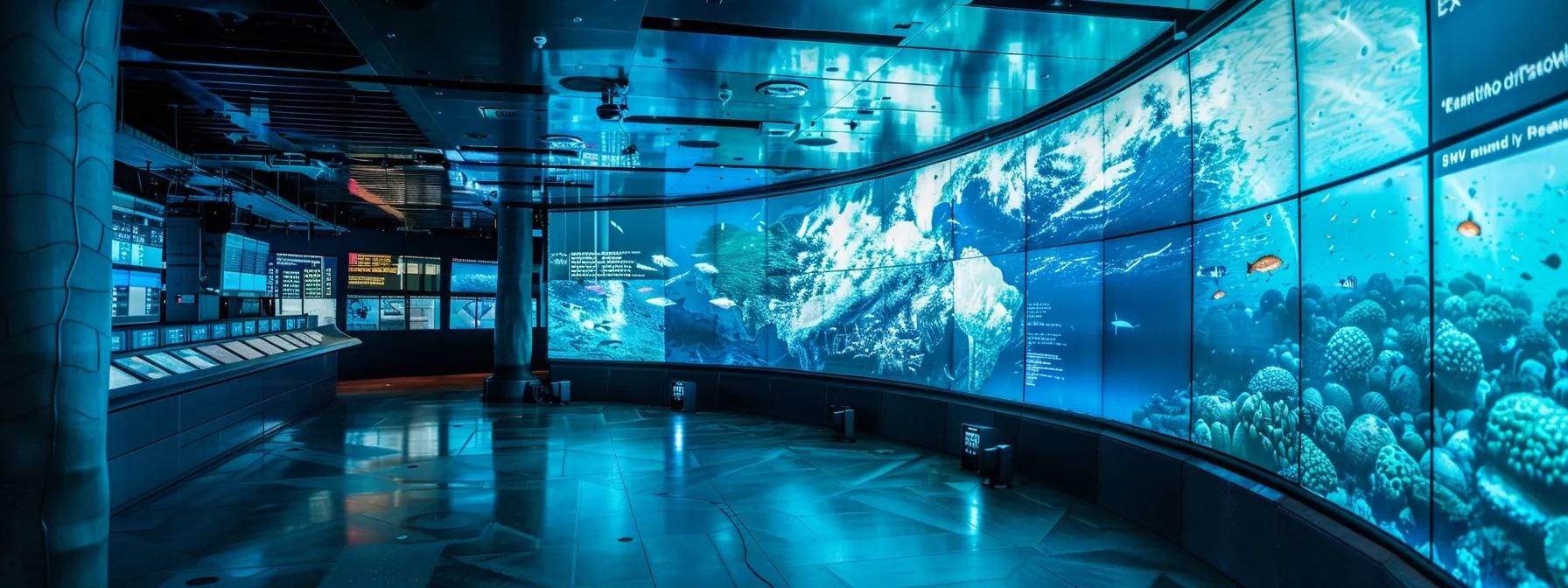Oceanic Upheaval: Understanding AMOC Weakness and Polar Feedback Loops Impact on Climate
The Earth’s climate system is an intricate network of interactions where ocean currents and polar processes play pivotal roles. Recent observations have noted dramatic changes in the Atlantic Meridional Overturning Circulation (AMOC) and polar feedback loops. The weakening of AMOC, together with accelerating polar ice melt, poses challenges for global climate. These changes affect weather patterns, sea levels, marine ecosystems, coastal communities, and the global radiation balance. This article explains AMOC’s mechanics, how polar feedback loops intensify climate change, and explores the global consequences and current scientific predictions. We also discuss monitoring tools and mitigation strategies.
Transitions between oceanic and atmospheric processes are closely connected; understanding these dynamics is essential for planning and future policy-making. The following sections break down each key area using a structured approach to offer a comprehensive overview of the evidence and scientific reasoning behind these changes.
What Is the Atlantic Meridional Overturning Circulation (AMOC)? And why does it matter?
AMOC is a key component of global ocean circulation. It consists of a system of currents in the Atlantic that redistributes heat, salt, and nutrients, thereby influencing global climate. Acting like a conveyor belt, it carries warm water from the tropics to the North Atlantic and brings cold, denser water southward. This circulation is crucial for moderating weather systems, sea levels, and daily climate conditions on both sides of the Atlantic.
How Does AMOC Regulate Global Ocean Circulation?
AMOC operates through thermohaline processes. AMOC heats tropical waters, which then become less dense and move northward. Upon reaching polar regions, cooling and salt addition (from evaporation and ice formation) increase their density, causing the water to sink and then flow southward along the deep ocean floor. This continuous cycle of surface and deep water flows helps to moderate temperature gradients, especially in Europe and North America, by transporting warm equatorial heat northward and stabilizing climatic conditions.
What Factors Are Causing AMOC Weakening?
Research shows that AMOC is weakening due to increased freshwater input from melting glaciers and polar ice and rising global temperatures. Enhanced ice melt—especially in Greenland—reduces the salinity and density of North Atlantic waters. In addition, increased precipitation and runoff add freshwater, hindering the sinking process critical for AMOC. Peer-reviewed studies report a decline in AMOC strength by 15–20% over recent decades, marking it as a significant concern in the context of anthropogenic climate change.
How Is AMOC Weakness Measured and Monitored?
Scientists monitor AMOC using a network of moored instruments—such as current meters and temperature-salinity sensors—alongside satellite observations of sea surface temperatures and sea level anomalies. Climate models, including those from the Coupled Model Intercomparison Project (CMIP), simulate AMOC behavior under various scenarios. The RAPID monitoring array at 26°N in the Atlantic provides real-time data that is critical for assessing AMOC fluctuations.
How Do Polar Feedback Loops Accelerate Climate Change?

Polar feedback loops are self-reinforcing processes triggered by changes in polar regions, particularly by rapid ice melt. As ice shrinks, the reflective surfaces (albedo) are reduced, causing darker surfaces to absorb more solar radiation. This in turn increases warming and promotes further ice melt, setting off a cycle that contributes significantly to climate change and affects global atmospheric circulation and ocean currents.
What Are Polar Feedback Loops and Their Types?
Several types of polar feedback loops accelerate warming. The most prominent is the albedo feedback, where loss of reflective ice leads to increased solar absorption. Other types include the lapse rate feedback, which alters radiative cooling rates at different atmospheric levels, and the water vapor feedback, as warmer air holds more moisture—a potent greenhouse gas. These feedbacks work simultaneously, magnifying initial warming and potentially accelerating regional temperature increases by several degrees Celsius over decades.
How Does Polar Ice Melt Influence Ocean Currents?
The melting of polar ice introduces large volumes of freshwater into the ocean, reducing seawater density and disturbing the normal sinking process critical to thermohaline circulation and AMOC. With less dense water available to sink, deep water formation declines, slowing the overall heat transport mechanism. Additionally, the resulting stratification in areas like the Arctic can disrupt nutrient cycles and affect marine ecosystems.
What Role Do Temperature and Albedo Changes Play in Feedback Loops?
Rising temperatures reduce ice coverage, which lowers surface albedo and allows more solar radiation to be absorbed. This accelerates further warming and ice melt. Studies indicate that even a modest 5–10% reduction in albedo can significantly boost absorbed heat energy, leading to regional warming by about 1.5 to 2 degrees Celsius over several decades. These interlinked effects heighten the urgency of addressing climate change.
What Are the Consequences of AMOC Weakening for Global Climate?
A weakened AMOC disrupts the distribution of heat across the Atlantic, triggering extensive climatic consequences. Less warm water reaches higher latitudes, potentially cooling parts of Europe and North America, while tropical regions may experience amplified warming. Such imbalances can lead to more frequent severe weather events, including storms, droughts, and unusual temperature patterns.
How Does AMOC Weakness Affect Weather Patterns Worldwide?
Changes in AMOC can alter the jet stream, storm tracks, and precipitation regimes globally. A reduced AMOC disturbs the balance between warm and cold water flows, contributing to greater weather variability. For instance, a weakened AMOC has been associated with unpredictable winters in Europe and increased storminess in the North Atlantic, as well as shifts in the position and intensity of the Intertropical Convergence Zone (ITCZ), affecting rainfall in tropical regions.
What Are the Risks to Coastal and Marine Ecosystems?
Coastal and marine ecosystems face significant risks from a slowing AMOC. Rising sea levels—driven by thermal expansion and altered ocean circulation—threaten coastal communities, while warmer and more stratified waters can limit nutrient mixing, impacting fisheries and reducing marine biodiversity. Changes in current patterns may also disrupt migration routes and lead to a decline in key species, including commercially valuable fish stocks and sensitive coral reefs.
How Could AMOC Changes Influence Sea Level Rise?
AMOC weakening may contribute to sea level rise in several ways. A slowdown in deep water formation can cause thermal expansion of warming water, while uneven heat distribution may result in regional sea level differences. Additionally, a reduced capacity of the ocean to sequester carbon could further elevate atmospheric CO₂ levels, intensifying global warming and accelerating polar ice melt, thereby compounding sea level risks.
How Does Polar Ice Melt Interact With Ocean Currents?

The influx of freshwater from melting polar ice impacts ocean currents by changing both the density and salinity of seawater. This disrupts the sinking process that drives the deep limb of AMOC and sets off a chain reaction affecting heat transport and carbon cycling on both regional and global scales.
What Is the Connection Between Polar Ice Melt and AMOC Disruption?
Freshwater from melting ice dilutes seawater salinity, reducing its density and impairing the sinking process essential to AMOC. Studies using climate models suggest that even small increases in freshwater input can significantly slow AMOC, which in turn enhances polar warming in a self-reinforcing cycle that undermines long-term climate stability.
How Do Freshwater Inputs From Melting Ice Affect Ocean Salinity?
In regions most affected by ice melt, particularly the North Atlantic, salinity can drop by 1–2 practical salinity units (PSU). These reductions weaken the density gradients required for deep water formation and disrupt ocean circulation while also altering chemical and biological processes within the marine environment.
What Are the Regional Differences in Polar Feedback Effects?
Polar feedback effects vary by region. In the Arctic, accelerated ice melt leads to a dramatic reduction in albedo and subsequent warming, while in the Antarctic, regional ocean dynamics create different mixing profiles and temperature shifts. Coastal regions receiving large freshwater inputs may experience localized circulation changes, leading to regional weather anomalies and uneven sea level rise.
What Are the Current Scientific Predictions for AMOC and Polar Feedback Loops?
Advanced climate models and observational data indicate that ongoing warming and freshwater input from polar ice melt will continue to weaken AMOC over the coming decades. Some models predict a decline of 15–30% over the next century under high-emission scenarios. At the same time, feedback loops from the polar regions are likely to get stronger, making global warming and extreme weather in certain areas worse, but there are still unknowns because the interactions between the ocean and atmosphere are complicated and we don’t have enough long-term data.
What Do Climate Models Forecast for AMOC Stability?
Current models consistently project a gradual weakening of AMOC, particularly if greenhouse gas emissions remain high. Factors such as increased freshwater flux, altered wind patterns, and changes in sea surface temperature all contribute to this weakening. Model ensembles indicate that AMOC may decline by 20–30%, with cascading impacts like regional cooling in Europe and heightened weather extremes globally.
How Might Polar Feedback Loops Intensify in the Coming Decades?
As global temperatures rise, enhanced baseline warming will accelerate ice melt and further reduce albedo. We expect this to intensify polar feedback loops, resulting in faster warming in the Arctic and Antarctic. Increased water vapor from warmer air will also strengthen the greenhouse effect, making these feedback loops more potent and contributing to greater climate variability and unpredictable extremes.
What Are the Uncertainties and Research Gaps in Current Understanding?
Despite significant progress, key uncertainties remain. Determining the precise freshwater thresholds that trigger rapid AMOC changes is challenging. We also have not fully settled the role of atmospheric circulation in modulating these changes and nonlinear feedback responses. Limitations in observational records and the interactions between biological and physical ocean processes contribute to these gaps. Continued improvements in high-resolution climate models and long-term data collection are essential to refine predictions.
How Can Society Respond to the Threats of AMOC Weakness and Polar Feedback Loops?

Addressing the challenges posed by AMOC weakening and polar feedback loops requires a dual approach: mitigation and adaptation. Mitigation efforts aim to reduce greenhouse gas emissions and slow warming, while adaptation strategies prepare communities for the impacts of altered weather patterns and rising sea levels. Effective policy, informed by current scientific evidence, is essential for coordinated global action.
What Mitigation Strategies Can Slow AMOC Decline?
Key mitigation strategies include reducing carbon dioxide and other greenhouse gas emissions through the transition to renewable energy, stringent emissions regulations, and enhanced energy efficiency. Protecting and restoring natural carbon sinks such as forests and wetlands is also critical. Research into cooling strategies or freshwater management may offer additional tools. International agreements like the Paris Agreement play an important role in aligning mitigation efforts across nations.
How Can Adaptation Efforts Address Climate Impacts From Oceanic Changes?
Adaptation measures involve reinforcing coastal infrastructure, such as seawalls and storm surge barriers, alongside sustainable urban planning. Improving water management, upgrading infrastructure, and developing early-warning systems for extreme weather events are necessary responses. Integrating up-to-date climate data into local planning and emergency preparedness programs can help communities better manage the uncertainties introduced by changes in AMOC and polar feedback loops.
What Role Do Policy and Public Awareness Play in Addressing Oceanic Upheaval?
Strong policy frameworks and heightened public awareness are essential. Policies that prioritize climate mitigation and adaptation drive investment in resilient infrastructure and research. Public education campaigns can promote behavioral changes that reduce carbon footprints, while improved media coverage and community engagement help ensure broad support. Together, these measures create a unified response bridging science, policy, and societal action.
What Are the Key Data Sources and Tools for Monitoring Oceanic Upheaval?
Monitoring oceanic changes relies on advanced technology and comprehensive data collection. Satellite instruments, oceanographic arrays, and in situ sensors are deployed to track variations in sea surface temperature, salinity, and current velocities. These real-time datasets are vital for calibrating climate models and forecasting changes in AMOC and polar feedback loops.
Which satellite and oceanographic instruments track AMOC and polar ice?
Satellite altimetry, as provided by the Jason series, measures sea surface height anomalies that signal changes in ocean circulation. In parallel, sensors on satellites from NASA and ESA monitor sea surface temperatures and ice cover. Mooring arrays like the RAPID array in the North Atlantic use current meters and CTD devices to supply continuous, high-resolution observational data.
How Are Interactive Visualizations Used to Communicate Ocean Changes?
Interactive visualizations integrate satellite imagery, in situ sensor data, and climate model outputs into dynamic maps and dashboards. These tools offer real-time updates on AMOC strength and polar ice melt, facilitating clearer understanding among policymakers, researchers, and the general public. By comparing historical and current data, these visualizations support informed decision-making and prompt timely responses to emerging climate risks.
Where Can the Public Access Reliable Information on AMOC and Polar Feedback?
Reliable information is available via reputable sources such as NOAA, the IPCC, and NASA. Peer-reviewed studies published by institutions like the Woods Hole Oceanographic Institution, along with interactive data portals from the European Centre for Medium-Range Weather Forecasts (ECMWF), provide up-to-date insights into ocean circulation changes and climate feedback mechanisms.
Final Thoughts
The changes in AMOC and polar feedback loops represent a formidable challenge that demands rigorous scientific research and proactive policy responses. As these dynamics drive shifts in weather patterns and sea levels, societal actions—ranging from reducing emissions to updating coastal infrastructure—are critical. Continued collaboration between scientists, policymakers, and the public will be key to mitigating impacts and building resilience against future climate risks.
Frequently Asked Questions
Q: What is AMOC and why is it important?
A: AMOC is the Atlantic Meridional Overturning Circulation, a system of ocean currents that redistributes tropical heat to the North Atlantic. It is vital for maintaining moderate climates and balancing global heat and water distribution.
Q: How does increased freshwater from polar ice melt affect AMOC?
A: Freshwater from melting ice reduces seawater salinity and density, impairing the sinking process that drives AMOC. This dilution weakens the circulation, disrupting global heat transport.
Q: What are polar feedback loops?
A: Polar feedback loops are self-reinforcing processes where melting ice lowers surface albedo, leading to increased solar absorption and further warming, which enhances ice melt and exacerbates climate change.
Q: Which tools are used to monitor changes in AMOC and polar ice?
A: Monitoring is conducted using satellite instruments (such as altimeters and sea surface temperature sensors) and in situ devices like current meters and CTD sensors, notably deployed in arrays like RAPID in the North Atlantic.
Q: What mitigation strategies can slow down the decline of AMOC?
A: Strategies include reducing greenhouse gas emissions, transitioning to renewable energy, protecting natural carbon sinks, and advancing research into novel cooling or freshwater management techniques.
Q: How do changes in ocean currents affect coastal regions?
A: Alterations in ocean currents can lead to regional sea level rise, increased extreme weather events, and shifts in nutrient distribution, impacting coastal infrastructure, ecosystems, and local economies.
Q: Where can informed stakeholders access the latest research on AMOC and polar feedback loops?
A: Research is available through organizations such as NOAA, NASA, and the IPCC, as well as through peer-reviewed journals and government research institutions dedicated to oceanography and climate change.

